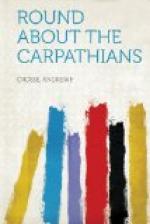[Footnote 6: Hungary and Transylvania, 1839.]
[Footnote 7: ‘Geographical Aspect of the Eastern Question,’ Fortnightly Review, January 1877.]
[Footnote 8: Transylvania: its Products and People.]
CHAPTER V.
Paraffine-works in Oravicza—Gold mine—Coal mines at Auima-Steirdorf—Geology—States Railway Company’s mines—Bribery.
The old copper and silver mines of Oravicza are now abandoned, but the industrial activity of the place is kept up by the working of coal mines, which have their depot here. The States Railway Company are the great owners of mines in this district. They confine their attention to iron and coal. There are extensive paraffine-works in Oravicza; the crude oil is distilled from the black shale of the Steirdorf coal, yielding five per cent of petroleum. At Moldova, where we were recently, the same company have large sulphuric acid works, employing as material the iron pyrites of the old mines. Moldova had formerly the reputation of producing the best copper in Europe, but the mines fell out of work, I believe, in 1848.
An English gentleman is working a gold mine near Oravicza with some success. Subsequent to my visit his people came upon what I think the miners call a “pocket” of free gold. Bismuth is also raised, though not in large quantities.
Wishing to see the coal mines at Steirdorf, I rode over the hills in about four hours. As I left Oravicza in the early morning the view appeared very striking. Looking back, I could see the little town straggling along in the shadow of the deeply-cleft valley, while beyond stretched the sunlit plain, level as a sea, rich with fields of ripe corn. The mists still lingered around me in the mountains, rolling about in the form of soft white masses of vapour, with here and there a fringed edge of iridescence. The cool freshness of the morning and the beauty of the varied scenery made the ride most enjoyable.
Arriving at Steirdorf, I spent some hours in visiting the ironworks, blast-furnaces, coke-ovens, &c. The coal produced here is said to be the best in Hungary. The output, I am told, is 150,000 tons; but only one-third of this is sold, the rest being used by the States Railway Company for their own ironworks, and for the locomotive engines of their line.
Professor Ansted,[9] who made a professional visit to this part of the country in 1862, remarks that “the iron is mined by horizontal drifts or kennels into the side of the hills. The coal is mined by vertical shafts. The ironstone is of the kind common to some parts of Scotland, and known as blackband. There are as many as eight principal seams.”
I had sent a man in advance from Oravicza to take my horse back, as I intended returning by rail. This mountain railway between Oravicza and Auima-Steirdorf is a remarkable piece of engineering work. In a distance of about twenty miles it ascends 1100 feet, in some parts as much as one foot in five. They have very powerful engines and a cogwheel arrangement, the line making a zigzag up the mountain-side. The effect is very curious in descending to see another train below you creeping uphill, now at one angle, now at another.




